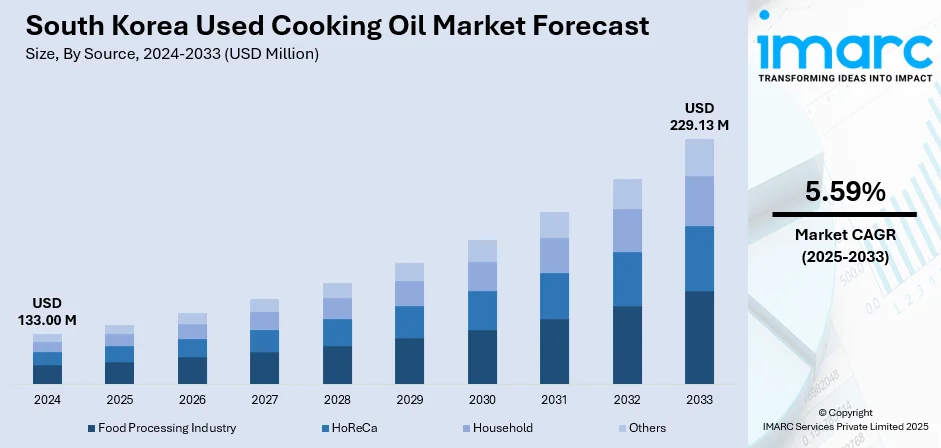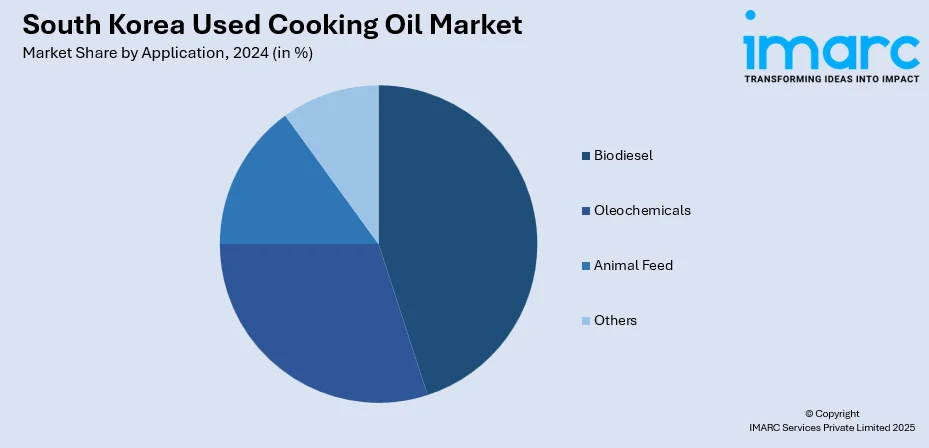
South Korea Used Cooking Oil Market Size, Share, Trends and Forecast by Source, Application, and Region, 2025-2033
South Korea Used Cooking Oil Market Overview:
The South Korea used cooking oil market size reached USD 133.00 Million in 2024. The market is projected to reach USD 229.13 Million by 2033, exhibiting a growth rate (CAGR) of 5.59% during 2025-2033. As more biodiesel plants are becoming operational, the integration of used cooking oil into the renewable energy supply chain is strengthening. Besides this, the growing execution of stringent regulations on waste oil disposal, which aids in promoting responsible handling and recycling practices across the foodservice sector, is contributing to the expansion of the South Korea used cooking oil market share.
|
Report Attribute
|
Key Statistics
|
|---|---|
|
Base Year
|
2024
|
|
Forecast Years
|
2025-2033
|
|
Historical Years
|
2019-2024
|
| Market Size in 2024 | USD 133.00 Million |
| Market Forecast in 2033 | USD 229.13 Million |
| Market Growth Rate 2025-2033 | 5.59% |
South Korea Used Cooking Oil Market Trends:
Increasing expenditure on biodiesel plants
Rising investments in biodiesel plants are playing a crucial role in fueling the market growth. As the country is intensifying its commitment to cleaner and more sustainable energy sources, significant funding is being directed towards the development and expansion of biodiesel production facilities. In April 2024, Hyundai Oilbank launched its new 130,000-Tons-per-year biodiesel plant in Daesan, South Korea. The majority of biodiesel generated was anticipated to satisfy the increasing local need for eco-friendly fuels in the country. These plants rely heavily on raw materials, such as used cooking oil, to produce biofuels, making the collection and supply of used cooking oil increasingly valuable. With the government encouraging low-carbon energy solutions and aiming to reduce dependence on fossil fuels, the biodiesel sector is gaining momentum, motivating both public and private investors to fund new projects and upgrade existing infrastructure. This trend is catalyzing a robust and reliable demand for used cooking oil, incentivizing households and food processing units to partner with waste oil collection services. The improved logistics and organized procurement processes around biodiesel plants also help streamline the flow of used cooking oil from urban and rural areas. Additionally, the rise in domestic and export-oriented biodiesel production is making used cooking oil a strategic input, increasing its market worth and volume. As more biodiesel plants are becoming operational, the integration of used cooking oil into the renewable energy supply chain is strengthening, ultimately supporting both environmental goals and economic opportunities within South Korea.

To get more information on this market, Request Sample
Stringent regulations on waste oil disposal
Stringent regulations on waste oil disposal are impelling the South Korea used cooking oil market growth. The government is implementing strict environmental policies that prohibit the improper dumping of used cooking oil into drainage systems or landfills due to its harmful impact on the environment. These rules require food establishments, industrial kitchens, and households to adhere to legal disposal standards, thereby creating a structured system for the collection and processing of used cooking oil. Regulatory compliance has encouraged businesses to partner with authorized recycling companies, leading to a more consistent and traceable supply of used cooking oil. Violators often face penalties, enabling both small and large foodservice operators to adopt sustainable waste oil management systems. Moreover, with the steady growth of South Korea’s foodservice sector, the generation of used cooking oil continues to increase, ensuring that regulatory frameworks play a critical role in managing this waste stream efficiently and sustainably. As per the IMARC Group, the South Korea foodservice market size is set to exhibit a growth rate (CAGR) of 18.80% during 2024-2032.
South Korea Used Cooking Oil Market Segmentation:
IMARC Group provides an analysis of the key trends in each segment of the market, along with forecasts at the country and regional levels for 2025-2033. Our report has categorized the market based on source and application.
Source Insights:
- Food Processing Industry
- HoReCa
- Household
- Others
The report has provided a detailed breakup and analysis of the market based on the source. This includes food processing industry, HoReCa, household, and others.
Application Insights:

- Biodiesel
- Oleochemicals
- Animal Feed
- Others
A detailed breakup and analysis of the market based on the application have also been provided in the report. This includes biodiesel, oleochemicals, animal feed, and others.
Regional Insights:
- Seoul Capital Area
- Yeongnam (Southeastern Region)
- Honam (Southwestern Region)
- Hoseo (Central Region)
- Others
The report has also provided a comprehensive analysis of all the major regional markets, which include Seoul Capital Area, Yeongnam (Southeastern Region), Honam (Southwestern Region), Hoseo (Central Region), and others.
Competitive Landscape:
The market research report has also provided a comprehensive analysis of the competitive landscape. Competitive analysis such as market structure, key player positioning, top winning strategies, competitive dashboard, and company evaluation quadrant has been covered in the report. Also, detailed profiles of all major companies have been provided.
South Korea Used Cooking Oil Market News:
- In August 2025, LG Chem began the construction of South Korea’s inaugural eco-friendly hydrotreated vegetable oil (HVO) facility in Seosan, South Chungcheong Province, utilizing plant-derived raw materials. The plant, with a yearly production capacity of 300,000 Tons, was set to be finished by 2027. HVO was an eco-friendly fuel created by infusing hydrogen into vegetable oils like used cooking oil and palm oil. It was viewed as a hopeful renewable energy option that could greatly lower greenhouse gas emissions.
- In January 2025, SK Energy achieved the successful export of sustainable aviation fuel (SAF) to Europe, a milestone for a South Korean refinery. It was created using co-processing techniques that enhanced bio-based substances like used cooking oil and animal fats.
South Korea Used Cooking Oil Market Report Coverage:
| Report Features | Details |
|---|---|
| Base Year of the Analysis | 2024 |
| Historical Period | 2019-2024 |
| Forecast Period | 2025-2033 |
| Units | Million USD |
| Scope of the Report |
Exploration of Historical Trends and Market Outlook, Industry Catalysts and Challenges, Segment-Wise Historical and Future Market Assessment:
|
| Sources Covered | Food Processing Industry, HoReCa, Household, Others |
| Applications Covered | Biodiesel, Oleochemicals, Animal Feed, Others |
| Regions Covered | Seoul Capital Area, Yeongnam (Southeastern Region), Honam (Southwestern Region), Hoseo (Central Region), Others |
| Customization Scope | 10% Free Customization |
| Post-Sale Analyst Support | 10-12 Weeks |
| Delivery Format | PDF and Excel through Email (We can also provide the editable version of the report in PPT/Word format on special request) |
Key Questions Answered in This Report:
- How has the South Korea used cooking oil market performed so far and how will it perform in the coming years?
- What is the breakup of the South Korea used cooking oil market on the basis of source?
- What is the breakup of the South Korea used cooking oil market on the basis of application?
- What is the breakup of the South Korea used cooking oil market on the basis of region?
- What are the various stages in the value chain of the South Korea used cooking oil market?
- What are the key driving factors and challenges in the South Korea used cooking oil market?
- What is the structure of the South Korea used cooking oil market and who are the key players?
- What is the degree of competition in the South Korea used cooking oil market?
Key Benefits for Stakeholders:
- IMARC’s industry report offers a comprehensive quantitative analysis of various market segments, historical and current market trends, market forecasts, and dynamics of the South Korea used cooking oil market from 2019-2033.
- The research report provides the latest information on the market drivers, challenges, and opportunities in the South Korea used cooking oil market.
- Porter's five forces analysis assist stakeholders in assessing the impact of new entrants, competitive rivalry, supplier power, buyer power, and the threat of substitution. It helps stakeholders to analyze the level of competition within the South Korea used cooking oil industry and its attractiveness.
- Competitive landscape allows stakeholders to understand their competitive environment and provides an insight into the current positions of key players in the market.
Need more help?
- Speak to our experienced analysts for insights on the current market scenarios.
- Include additional segments and countries to customize the report as per your requirement.
- Gain an unparalleled competitive advantage in your domain by understanding how to utilize the report and positively impacting your operations and revenue.
- For further assistance, please connect with our analysts.
 Request Customization
Request Customization
 Speak to an Analyst
Speak to an Analyst
 Request Brochure
Request Brochure
 Inquire Before Buying
Inquire Before Buying




.webp)




.webp)












